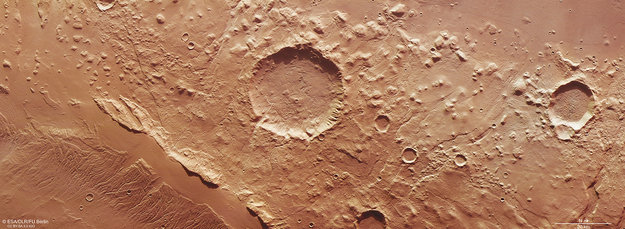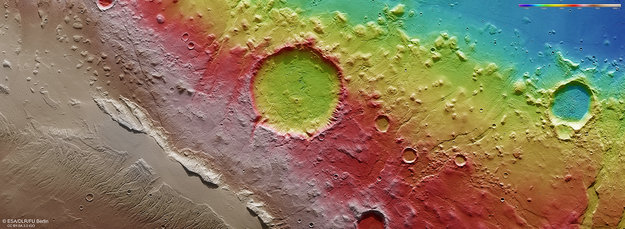A record of ancient tectonic stress on Mars
3 November 2016 Sets of ridges and troughs some 1000 km north of the giant Olympus Mons volcano contain a record of the intense tectonic stresses and strains experienced in the Acheron Fossae region on Mars 3.7–3.9 billion years ago.
This scene, captured by ESA’s Mars Express on 4 May, focuses on the western part of Acheron Fossae, an isolated block of ancient terrain that covers an area about 800 km long and 280 km wide and stands up to 2 km higher than the surrounding plains.
Acheron Fossae is part of a network of fractures that radiates from the Tharsis ‘bulge’ some 1000 km to the south, home to the largest volcanoes on Mars. As the Tharsis region swelled with hot material rising from deep inside Mars as the volcanoes formed, it stretched and pulled apart the crust along lines of weakness over a wide area.
This process gave rise to the classic ‘horst and graben’ system – a series of depressions (graben) bounded by faults and uplifted blocks (horsts) either side of the graben.
The pattern of cross-cutting faults seen in various places in Acheron Fossae implies the region experienced stresses from different directions over time, suggesting a complex history.
Part of a dominant, curved ridge that extends through the entire region is seen in the lower left of the scene. It may be an ancient graben that has since been filled with material that has flowed along it, possibly from rock-laden glaciers that were deposited in more recent cold climatic conditions, long after the graben itself formed.
Acheron Fossae has been likened to Earth’s continental rift systems. Major rift zones on Earth are associated with plate tectonics, such as mid-ocean ridges that are spreading apart.
On Mars, rifts are important for studies of the general evolution of the crust as well as the thermal evolution of the deeper subsurface.
Guillermo Gonzalo Sánchez Achutegui
ayabaca@gmail.com
ayabaca@hotmail.com
ayabaca@yahoo.com
Inscríbete en el Foro del blog y participa : A Vuelo De Un Quinde - El Foro!






No hay comentarios:
Publicar un comentario